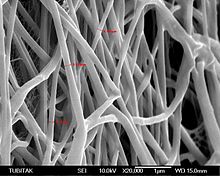- Nanofiber
-
Nanofibers are defined as fibers with diameters less than 1000 nm nanometers. They can be produced by interfacial polymerization and electrospinning. Carbon nanofibers are graphitized fibers produced by catalytic synthesis. For optical nanofibers see subwavelength-diameter optical fiber.
Contents
Synthesis
Inorganic nanofibers (sometimes called ceramic nanofibers) can be prepared from various kinds of inorganic substances by electrospinning technique. The most frequently mentioned ceramic materials with nanofiber morphology are titanium dioxide (TiO2), silicon dioxide (SiO2), zirconium dioxide (ZrO2), aluminum oxide (Al2O3), lithium titanate (Li4Ti5O12), titanium nitride (TiN) or platinum (Pt). The synthesis usually consists of two main steps. In the first step, the polymer (organic) nanofibers are created by conventional electrospinning technique. As prepared, polymer nanofibers made of inorganic salts or organometallic compounds are subsequently transformed to ceramics by heat treatment. Other production methods include direct drawing from a solution or melt and "island in the sea".
Potential applications
- Medical: artificial organ components, tissue engineering, implant material, drug delivery,[1] wound dressing, medical textile materials.
- Protective materials: sound absorption materials, protective clothings against chemical and biological warfare agents, sensor applications for detecting chemical agents.
- Textile: sport apparels, sport shoes, climbing, rainwear, outerwear garments, baby diapers.
- Filtration: HVAC system filters, HEPA, ULPA filters, air, oil, fuel filters for automotive, filters for beverage, pharmacy, medical applications.
- Napkins with nanofibers contain antibodies against numerous biohazards and chemicals that signal by changing color (potentially useful in identifying bacteria in kitchens).
- In wound healing nanofibers assemble at the injury site and stay put, drawing the body's own growth factors to the injury site.
- Filter media for new air and liquid filtration applications, such as vacuum cleaners.
- Dye-sensitized solar cell
- Pigments for cosmetics
- Energy: Li-ion batteries, photovoltaic cells, membrane fuel cells.
- Carrier materials for various catalysts
- Photocatalytic air/water purification
- Micropower to operate personal electronic devices via piezoelectric nanofibers woven into clothing.
Self-twisting
Self-brading of nanofibers is related to a balance between flexibility, adhesion, and evaporation of solvent. Its potential applications include:[2]
- Substances that can change optical properties on demand
- Molecule capture and release for e.g. timed drug delivery
- Energy storage
- Adhesives
See also
- Subwavelength-diameter optical fiber
- Nanofiber seeding
- Polyaniline nanofibers
References
- ^ Nagy ZK; Balogh A, Vajna B, Farkas A, Patyi G, Kramarics A, Marosi G (2011). "Comparison of Electrospun and Extruded Soluplus-Based Solid Dosage Forms of Improved Dissolution". Journal of Pharmaceutical Sciences. doi:10.1002/jps.22731.
- ^ Nests, Braids And Twists, On The Nano Scale
Categories:- Fibers
- Nanomaterials
- Technology stubs
Wikimedia Foundation. 2010.

